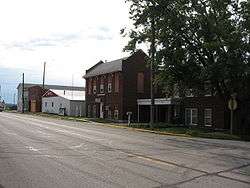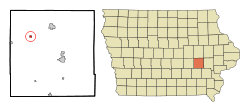Ladora, Iowa
Ladora is a city in Iowa County, Iowa, United States. The population was 283 at the 2010 census.
Ladora, Iowa | |
|---|---|
 Downtown Ladora, 2007 | |
 Location of Ladora, Iowa | |
| Coordinates: 41°45′18″N 92°11′2″W | |
| Country | |
| State | |
| County | Iowa |
| Area | |
| • Total | 0.29 sq mi (0.76 km2) |
| • Land | 0.29 sq mi (0.76 km2) |
| • Water | 0.00 sq mi (0.00 km2) |
| Elevation | 781 ft (238 m) |
| Population | |
| • Total | 283 |
| • Estimate (2019)[3] | 274 |
| • Density | 928.81/sq mi (359.16/km2) |
| Time zone | UTC-6 (Central (CST)) |
| • Summer (DST) | UTC-5 (CDT) |
| ZIP code | 52251 |
| Area code(s) | 319 |
| FIPS code | 19-42330 |
| GNIS feature ID | 0458168 |
Geography
Ladora is located at 41°45′18″N 92°11′2″W (41.754903, -92.183925).[5]
According to the United States Census Bureau, the city has a total area of 0.30 square miles (0.78 km2), all land.[6]
Demographics
| Year | Pop. | ±% |
|---|---|---|
| 1880 | 211 | — |
| 1890 | 224 | +6.2% |
| 1900 | 239 | +6.7% |
| 1910 | 260 | +8.8% |
| 1920 | 340 | +30.8% |
| 1930 | 284 | −16.5% |
| 1940 | 300 | +5.6% |
| 1950 | 273 | −9.0% |
| 1960 | 307 | +12.5% |
| 1970 | 321 | +4.6% |
| 1980 | 289 | −10.0% |
| 1990 | 308 | +6.6% |
| 2000 | 287 | −6.8% |
| 2010 | 283 | −1.4% |
| 2019 | 274 | −3.2% |
| Source:"U.S. Census website". United States Census Bureau. Retrieved 2020-03-29. and Iowa Data Center Source: | ||
2010 census
As of the census[2] of 2010, there were 283 people, 116 households, and 71 families living in the city. The population density was 943.3 inhabitants per square mile (364.2/km2). There were 126 housing units at an average density of 420.0 per square mile (162.2/km2). The racial makeup of the city was 96.8% White, 2.5% African American, and 0.7% from two or more races. Hispanic or Latino of any race were 1.1% of the population.
There were 116 households, of which 34.5% had children under the age of 18 living with them, 44.0% were married couples living together, 9.5% had a female householder with no husband present, 7.8% had a male householder with no wife present, and 38.8% were non-families. 32.8% of all households were made up of individuals, and 10.4% had someone living alone who was 65 years of age or older. The average household size was 2.44 and the average family size was 3.11.
The median age in the city was 34.9 years. 25.1% of residents were under the age of 18; 10.2% were between the ages of 18 and 24; 27.3% were from 25 to 44; 28.6% were from 45 to 64; and 8.8% were 65 years of age or older. The gender makeup of the city was 49.1% male and 50.9% female.
2000 census
As of the census[8] of 2000, there were 287 people, 121 households, and 75 families living in the city. The population density was 937.8 people per square mile (357.5/km2). There were 129 housing units at an average density of 421.5 per square mile (160.7/km2). The racial makeup of the city was 99.65% White, 0.35% from other races. Hispanic or Latino of any race were 1.39% of the population.
There were 121 households, out of which 31.4% had children under the age of 18 living with them, 52.9% were married couples living together, 5.8% had a female householder with no husband present, and 38.0% were non-families. 32.2% of all households were made up of individuals, and 15.7% had someone living alone who was 65 years of age or older. The average household size was 2.37 and the average family size was 3.05.
In the city, the population was spread out, with 26.1% under the age of 18, 8.7% from 18 to 24, 32.4% from 25 to 44, 18.5% from 45 to 64, and 14.3% who were 65 years of age or older. The median age was 36 years. For every 100 females, there were 120.8 males. For every 100 females age 18 and over, there were 107.8 males.
The median income for a household in the city was $36,875, and the median income for a family was $48,333. Males had a median income of $30,156 versus $21,528 for females. The per capita income for the city was $15,888. About 7.4% of families and 8.5% of the population were below the poverty line, including 5.0% of those under the age of eighteen and 8.6% of those 65 or over.
Education
H-L-V Community School District operates area public schools.[9]
Rolle Bolle
Ladora's Rolle Bolle courts are located behind Locust Street and Iowa Street. The traditional Belgian yard game, which is still being played by locals, was originally imported to the region by Belgian immigrants in the late 19th and early 20th centuries.[10] It is also played in the nearby towns of Belle Plaine, Clutier, Victor, Marengo, and Blairstown.
Notable person
- Mildred Wirt Benson, journalist and author
References
- "2019 U.S. Gazetteer Files". United States Census Bureau. Retrieved July 17, 2020.
- "U.S. Census website". United States Census Bureau. Retrieved 2012-05-11.
- "Population and Housing Unit Estimates". United States Census Bureau. May 24, 2020. Retrieved May 27, 2020.
- The History of Iowa County, Iowa: Containing a History of the County, Its Cities, Towns, &c. Union Historical Company. 1881. pp. 563–564.
- "US Gazetteer files: 2010, 2000, and 1990". United States Census Bureau. 2011-02-12. Retrieved 2011-04-23.
- "US Gazetteer files 2010". United States Census Bureau. Archived from the original on 2012-01-25. Retrieved 2012-05-11.
- "Census of Population and Housing". Census.gov. Retrieved June 4, 2015.
- "U.S. Census website". United States Census Bureau. Retrieved 2008-01-31.
- "H-L-V" (PDF). Iowa Department of Education. Retrieved 2020-04-16.
- Amato, Joseph Anthony. (1990). Servants of the land : God, family, and farm : the trinity of Belgian economic folkways in southwestern Minnesota. Longmont, Colo.: Crossings Press. ISBN 0961411929. OCLC 24039158.